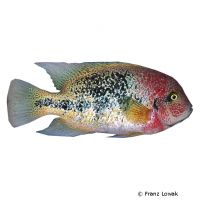Blackstripe Cichlid (Vieja fenestrata)
| Blackstripe Cichlid Vieja fenestrata | |
|---|---|
| Name | Blackstripe Cichlid |
| Name Lat. | Vieja fenestrata |
| Synonym | Cichlasoma fenestratum |
| Family | Cichlids |
| Family lat. | Cichlidae |
| Order | Cichlids |
| Order lat. | Cichliformes |
| Origin | Mexico |
| Habitat | Lakes, rivers |
| Diet | Omnivore |
| pH | 7.0-8.0 |
| Behavior | Semi-aggressive |
| Keeping | Pair |
| Care Level | Moderate |
| Reproduction | Substrate spawner |
| Breeding | Moderately difficult |
| Life Span | N/A |
| Protection | No |
| Metric Units | |
| Size | 25-30 cm |
| Temperature | 24-28 °C |
| Hardness | 10-15 °dH |
| Aquarium | ~ 500 l |
| US Units | |
| Size | 10"-12" |
| Temperature | 75-82 °F |
| Hardness | 178-267 ppm |
| Aquarium | ~ 130 gal |
Distribution and habitat
Fenestrata cichlids, also called redheads, are widely distributed in southwestern Mexico, from the Rio Papaloapan watershed to the Rio Chachalacas. They reside mainly in clear lakes, but also in stagnant sections of some rivers with sandy muddy bottoms, roots and sometimes dense aquatic vegetation.
Maintenance
The aquarium should have a dense border planting, with many hiding places (stones, roots), and offer free swimming space. A substrate of sand covered with some foliage (e.g. sea almond leaves) and shaded light (floating plants) is ideal.
No ammonia, ammonium and nitrite should be detectable, the nitrate value should not exceed 100 mg/l. To ensure water quality and oxygen content, a filter and heater adapted to the size of the aquarium is required, as well as lighting for the species-appropriate day-night rhythm of the animals.
Diet
The food supply consists of high-quality dry food for cichlids (pellets, granules), supplemented with some live or frozen food, such as artemia, mysis, shrimps and red mosquito larvae or a commercially available, frozen special food mix for cichlids. Furthermore, they need sufficient vegetable food, such as spinach, crushed peas, algae leaves or dry food with high vegetable content (spirulina).
Only feed as much as will be eaten within a few minutes. A regular and varied diet promotes health and increases resistance.
Behaviour and compatibility
It is recommended to keep them in pairs. They are internally less aggressive than their conspecifics. During the spawning season they behave territorial and defend their territory emphatically. Group keeping is only recommended in a much larger, richly structured tank. They can be socialized with other robust Central American cichlids. They regard fish that are too small as food. Basically, only compatible fish species with similar demands on water condition and water temperature may be socialized.
Sex dimorphism
The males are slightly larger, more intensely colored, have longer extended fins and a frontal hump. The smaller females have a dark area in the dorsal fin.
Reproduction and breeding
They spawn on shallow stones or roots (open brooders), sometimes also in caves. Both parents perform brood care and intensively defend the territory (parental family). After 2-3 days, the fry hatch and are then housed and guarded in a bottom pit prepared outside the cave until they swim free after 4-5 days and brood care ends
Fry must be fed several times a day with special rearing food (e.g. Artemia nauplii). In community tanks breeding is hardly possible, because the fry are easy prey.
Important
Since they like to burrow, stone structures must be well secured.
The foliage (sea almond tree, oak, etc.) enriches the water with humic substances, naturally lowers the pH and is a valuable secondary food source (detritus)
The well-being of the fish should be monitored regularly. Temperature should be checked daily, pH, hardness and nitrate levels at least every 14 days. Regular partial water changes are recommended, even if the contaminant level has not yet reached the upper limit. Sudden changes in water quality should be avoided. Newly introduced fish must be accustomed slowly to the water in the aquarium.
Further literature can be found in your pet store.
References
Text: Werner Winter; Image: Franz Lowak
Source: BMEL (1998): Tierschutzgutachten - Haltung von Zierfischen (Süßwasser); RIEHL & BAENSCH (2004): Aquarien Atlas Bd. 3, Mergus Verlag; ENGELMANN (2005): Zootierhaltung - Tiere in menschlicher Obhut: Fische, Verlag Harri Deutsch
- Gemäß § 21 Abs. 5 Tierschutzgesetz idgF
